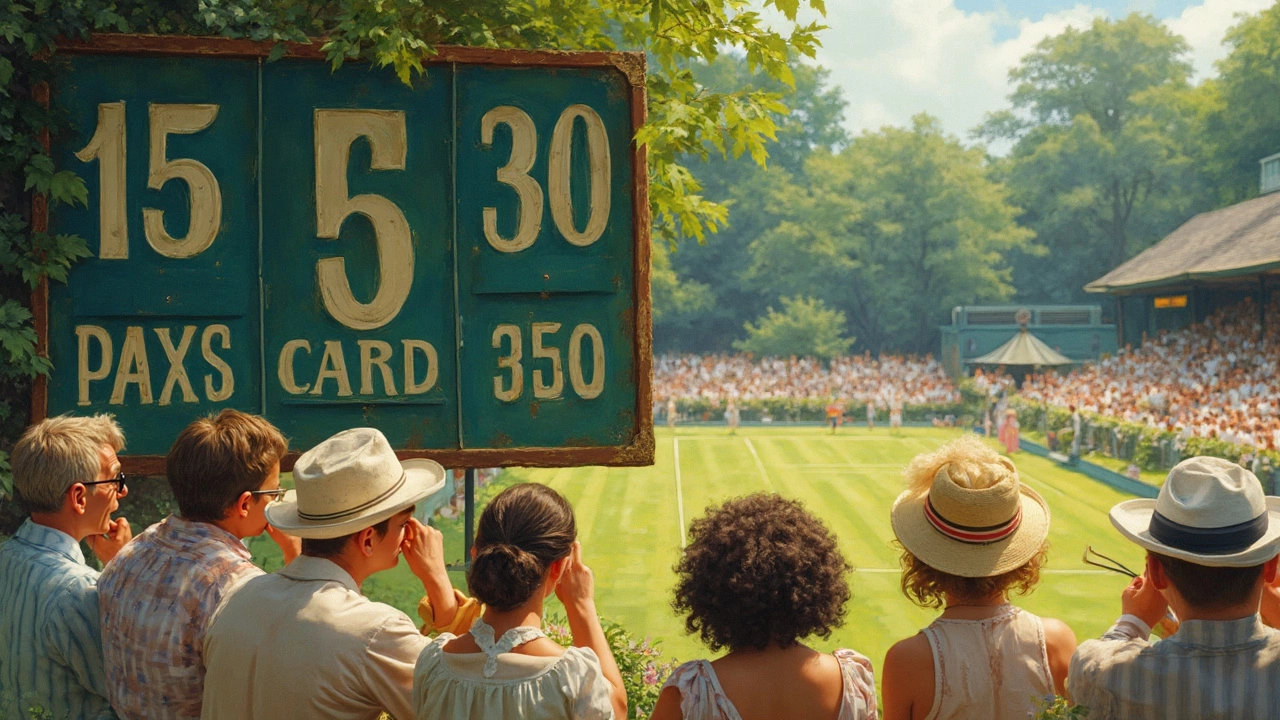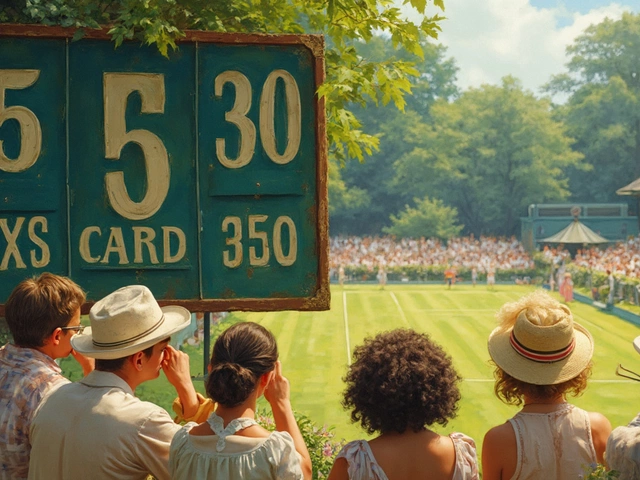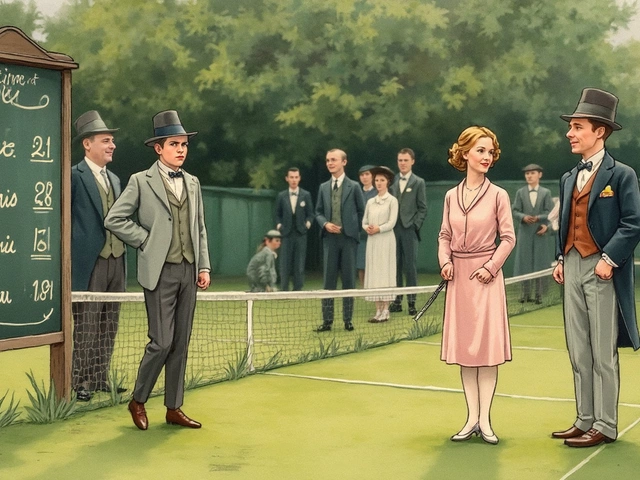Why is it 40 and Not 45 in Tennis Scoring?

Ever looked at a tennis scoreboard and thought, "Why on earth is it 15, 30, then 40? Shouldn't it be 45 right after 30?" You're not the only one who's puzzled. Even seasoned tennis fans (and yes, the odd dog sprawled at your feet—Max, looking at you) have asked this. The 40 in tennis scoring seems totally random, but there's a real reason for it.
If you're just getting into tennis, knowing the backstory behind this quirky scoring system can make watching or playing feel a bit less confusing. Plus, it gives you some solid trivia to throw out when matches get tense. Understanding why tennis isn't 15-30-45-60, or something more logical, makes you realize the game's not just about swinging a racket—there's history baked into every point.
Getting this scoring thing down is more than a flex for your brain. When you truly understand how and why the numbers work, things like calling score, following tight games, or even umpiring in a local league make way more sense. Let's unpack where this odd '40' came from and why it stuck around long enough to trip up new and experienced players alike.
- Weird Origins of Tennis Scoring
- Decoding Why 40 Replaced 45
- Lasting Impact on Tournaments
- Pro Tips on Mastering the Scoreboard
Weird Origins of Tennis Scoring
The way we count points in tennis seems totally random if you don’t know the backstory. Originally, the scoring comes from a much older game called jeu de paume, a French handball game that was popular before rackets were even a thing. The numbers—15, 30, and 40—actually started out as 15, 30, and 45. No joke, the original idea was to mark out the 60 minutes of an hour on a clock face. Each point meant another quarter of the clock: 15, 30, 45, and then 60 to win. It was all about making the game easy to keep track of, which is funny looking back now.
So where did tennis lose five points? Sometime in the 16th or 17th century, historians say, people started calling the third point "40" instead of "45." Some think it was just because saying "forty-five" took too long or was hard to shout during a match. Others figure 45 got rounded down for the sake of speed. The real truth is a little fuzzy, but written records from the oldest tennis clubs show by the late 1600s, "40" was the standard.
This bizarre clock-based system stuck around even as tennis moved from French courtyards to British lawns. Even when the rules became more official in the late 1800s, and tennis tournaments popped up everywhere, nobody felt the need to change those strange numbers. It stuck, and now it’s part of what people actually love about tennis—even if it baffles newcomers.
Want to sound smart at your next match? Drop that fun fact about the scoring system coming from a clock face. Most people—even fans of tennis scoring—still get a kick out of how weirdly tradition keeps shaping the sport today.
Decoding Why 40 Replaced 45
This is where things get interesting for tennis fans. Originally, tennis points were supposed to go up as 15, 30, 45, and 60. The idea behind this was that scores would be easy to track using the face of an old clock. Each point would move the hand a quarter way around: 15, 30, 45, and then 60 for game. Smart, right?
But here’s the twist: at some point, 45 got chopped down to 40. Why? The most accepted theory is that saying "forty-five" took too long when calling out scores and just made life harder for officials and players. Saying "forty" was faster. Another reason: old French scorekeepers wrote the numbers as “15,” “30,” and “40” on boards, possibly due to space or tradition. Once people got used to this shortcut, it stuck. The French word for 40, “quarante,” is shorter than “quarante-cinq,” which helped speed up the game’s pace too. Eventually, clubs in England and France just rolled with it.
Check out how the numbering looked then and now:
| Original Point | Modern Tennis Point |
|---|---|
| 15 | 15 |
| 30 | 30 |
| 45 | 40 |
| 60 | Game |
This isn’t the only weird quirk. Think about "deuce"—instead of going right to 60 and ending the game, players get stuck in the back-and-forth at 40–all because of this odd scoring jump.
- If you’re playing a match, just remember: "40" is really just an old "45." Don’t overthink it—no one else in tennis is doing math either!
- When watching tennis tournaments on TV, next time you hear "forty-love," you’ll know it’s really just a bit of tradition that never fixed itself.
Bottom line: there’s no secret math. The shift from 45 to 40 was all about making the game run smoother and a little less tongue-twisting for everyone involved. Even the best commentators in the world just run with it—and now, so can you.

Lasting Impact on Tournaments
The odd jump from 30 to 40 in tennis scoring isn’t just a relic from the past—it still shapes how tournaments play out today. If you watch any Grand Slam, you’ll notice how the scoreline can get tense fast when someone reaches 40. This quirky system means every point after 30 feels way more intense, especially when it’s game point or deuce. The drama of a tight match often comes from that pressure boiling up at 40, not some random number like 45 that never caught on.
The system also affects how matches are tracked and broadcast. TV graphics, stadium scoreboards, and even umpire calls all revolve around that jump from 30 to 40. According to a tech report from the ATP Tour in 2023, real-time scoring apps and tournament systems are all programmed specifically for these numbers. A sudden switch to 45 would break years of stats and data tracking. Here’s a quick look at how point scoring impacts major events:
| Tournament | Official Scoring System | Related Technology |
|---|---|---|
| Wimbledon | Traditional 15-30-40 | Hawk-Eye, IBM SlamTracker |
| US Open | Traditional 15-30-40 | IBM Statcast AI |
| Australian Open | Traditional 15-30-40 | Infosys Match Centre |
| French Open | Traditional 15-30-40 | French Tennis Federation portal |
This system doesn’t just impact pros. Local leagues and schools stick with this scoring because it’s the norm everywhere. If you showed up to your local tournament and started calling “45” instead of “40,” you’d definitely get looks—and probably a confused umpire, too.
James Blake, former top-10 player and ESPN commentator, once joked,
"I’ve played tennis my whole life and 40 still makes me pause sometimes. If we ever switched to 45, I think the world might just stop turning on its axis for a second."
The mental game is huge here as well. Chasing down a 40-30 deficit can feel way more urgent than if the number were just 45. Players, coaches, and fans treat 40 like the final hill before you hit the summit. Changing it now would mess with the whole flow—so don’t expect any updates on this front soon.
Pro Tips on Mastering the Scoreboard
Knowing tennis scores is cool, but actually keeping up with the fast action on court is another story. Here’s how you can avoid getting tripped up by the numbers, whether you’re playing, reffing, or just watching like a pro.
- Say the Server’s Score First: Always announce the server’s score before the receiver’s. It’s how it goes at all levels, from junior tours to Slam finals. If you’re serving and just won the last point, you’d call out “30-15.” If you’re on the other side and haven’t won a point, it’s “15-0.”
- Don’t Forget About Deuce and Advantage: When the score hits 40-40, that’s called “deuce.” The next point is “advantage.” If the server wins it, say “advantage in.” If the receiver takes it, it’s “advantage out.” You’ve got to win two points in a row from deuce to take the game.
- Memorize the Sequence: Get the numbers in your head—15, 30, 40, game. Trust me, after a few matches, you won't even think about it. Some people quietly repeat the sequence during changeovers or when the match gets tense.
- Handy Scoreboard Tip: When keeping score by hand or using a manual board, point markers help. Just slide the marker or flip the number after each point so everyone sees the real-time score. This is super useful in club matches or tournaments where electronic displays aren’t around.
Here’s a quick look at how six common game scores break down. Use this as a cheat sheet until you’ve got it down cold:
| Server's Points | Receiver's Points | Score Announcement |
|---|---|---|
| 0 | 0 | Love-all |
| 15 | 0 | 15-love |
| 30 | 15 | 30-15 |
| 40 | 30 | 40-30 |
| 40 | 40 | Deuce |
| Advantage | 40 | Advantage-in |
Here’s another tip: Players and refs often use fingers or even ball positions on their rackets for a quick tally, especially during windy matches where scoreboards fall over or when you're caught daydreaming about your post-match meal.
If you’re at a big tennis scoring event, keep your phone’s tennis app handy—most tournament apps update the score in real-time, so you never have to wonder if you’ve missed a point. And if you’re the ref, always double-check before calling out the final score of a game. It avoids plenty of awkward arguments after a tense rally.



